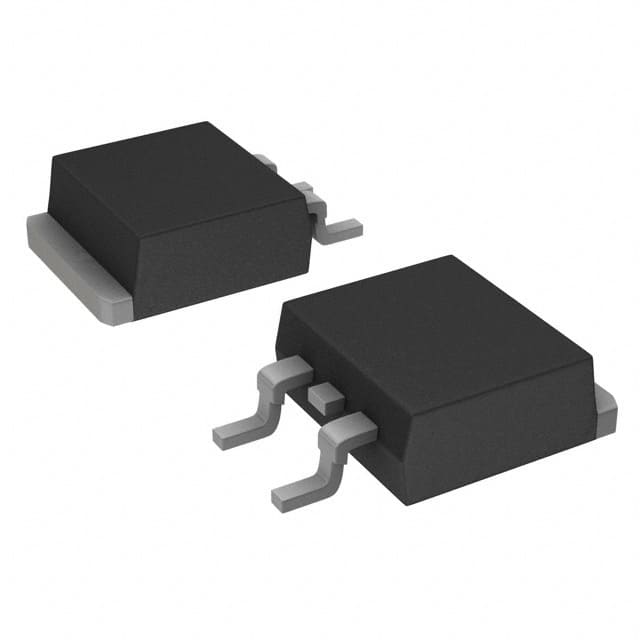SBLB1630CTHE3/45
Introduction
The SBLB1630CTHE3/45 is a semiconductor product that belongs to the category of Schottky Barrier Rectifiers. This entry provides an overview of the basic information, specifications, pin configuration, functional features, advantages and disadvantages, working principles, application field plans, and alternative models of the SBLB1630CTHE3/45.
Basic Information Overview
- Category: Schottky Barrier Rectifiers
- Use: The SBLB1630CTHE3/45 is commonly used in power supply applications, voltage clamping, and reverse polarity protection.
- Characteristics: It exhibits low forward voltage drop, high-frequency operation capability, and fast switching.
- Package: The SBLB1630CTHE3/45 is typically available in a TO-263AB package.
- Essence: It is designed to provide efficient rectification and power management in various electronic circuits.
- Packaging/Quantity: The product is usually packaged in reels or tubes, with quantities varying based on manufacturer specifications.
Specifications
The key specifications of the SBLB1630CTHE3/45 include: - Forward Voltage Drop: 0.55V at 8A - Reverse Voltage: 30V - Average Rectified Current: 16A - Maximum Operating Temperature: 175°C - Storage Temperature Range: -65°C to 175°C
Detailed Pin Configuration
The SBLB1630CTHE3/45 typically features a standard pin configuration with the following connections: - Pin 1: Anode - Pin 2: Cathode
Functional Features
The functional features of the SBLB1630CTHE3/45 include: - Low forward voltage drop for reduced power dissipation - High-frequency operation capability for efficient switching - Fast reverse recovery time for improved performance in power supply applications
Advantages and Disadvantages
Advantages
- Efficient power management due to low forward voltage drop
- Suitable for high-frequency operation
- Fast switching characteristics
Disadvantages
- Limited reverse voltage rating compared to some other rectifier options
- Higher cost compared to standard diodes
Working Principles
The SBLB1630CTHE3/45 operates based on the Schottky barrier principle, where the metal-semiconductor junction allows for fast switching and low forward voltage drop. When a forward bias is applied, the rectifier conducts current with minimal voltage loss, making it suitable for high-efficiency applications.
Detailed Application Field Plans
The SBLB1630CTHE3/45 finds extensive use in the following application fields: - Power supply units - Voltage clamping circuits - Reverse polarity protection circuits - Switching power supplies - DC-DC converters
Detailed and Complete Alternative Models
Some alternative models to the SBLB1630CTHE3/45 include: - SB160 - SS310 - SR5100
These alternative models offer similar characteristics and are compatible with various applications requiring Schottky barrier rectifiers.
In conclusion, the SBLB1630CTHE3/45 is a versatile semiconductor product that offers efficient rectification and power management capabilities. Its low forward voltage drop, high-frequency operation, and fast switching characteristics make it suitable for a wide range of electronic applications.
Word Count: 443
기술 솔루션에 SBLB1630CTHE3/45 적용과 관련된 10가지 일반적인 질문과 답변을 나열하세요.
What is the SBLB1630CTHE3/45 used for in technical solutions?
- The SBLB1630CTHE3/45 is a Schottky diode designed for use in various technical solutions, including power supplies, voltage clamping, and reverse polarity protection.
What are the key specifications of the SBLB1630CTHE3/45?
- The SBLB1630CTHE3/45 has a maximum average forward current of 16A, a reverse voltage of 30V, and a low forward voltage drop, making it suitable for high-efficiency applications.
How does the SBLB1630CTHE3/45 contribute to power supply designs?
- The SBLB1630CTHE3/45's low forward voltage drop and high current capability make it ideal for use in power supply designs, where efficiency and reliability are crucial.
Can the SBLB1630CTHE3/45 be used for voltage clamping?
- Yes, the SBLB1630CTHE3/45 is commonly used for voltage clamping applications due to its fast response time and low clamping voltage.
In what scenarios is reverse polarity protection important, and how does the SBLB1630CTHE3/45 address this need?
- Reverse polarity protection is critical in applications where accidental reverse voltage can damage sensitive components. The SBLB1630CTHE3/45 provides effective reverse polarity protection by quickly conducting current in the reverse direction.
What are the temperature considerations for using the SBLB1630CTHE3/45 in technical solutions?
- The SBLB1630CTHE3/45 is designed to operate over a wide temperature range, making it suitable for various environmental conditions typically encountered in technical solutions.
Are there any application notes or reference designs available for incorporating the SBLB1630CTHE3/45 into technical solutions?
- Yes, manufacturers often provide application notes and reference designs to assist engineers in integrating the SBLB1630CTHE3/45 into their technical solutions.
How does the SBLB1630CTHE3/45 compare to other diodes in similar applications?
- The SBLB1630CTHE3/45 offers a balance of low forward voltage drop, high current capability, and fast switching characteristics, making it a competitive choice for many technical solutions.
What are the typical failure modes associated with the SBLB1630CTHE3/45, and how can they be mitigated?
- Common failure modes include thermal overstress and reverse voltage breakdown. Proper heat sinking and circuit protection measures can help mitigate these risks.
Can the SBLB1630CTHE3/45 be used in automotive or industrial applications?
- Yes, the SBLB1630CTHE3/45 is suitable for automotive and industrial applications due to its robust construction and reliable performance under harsh operating conditions.


